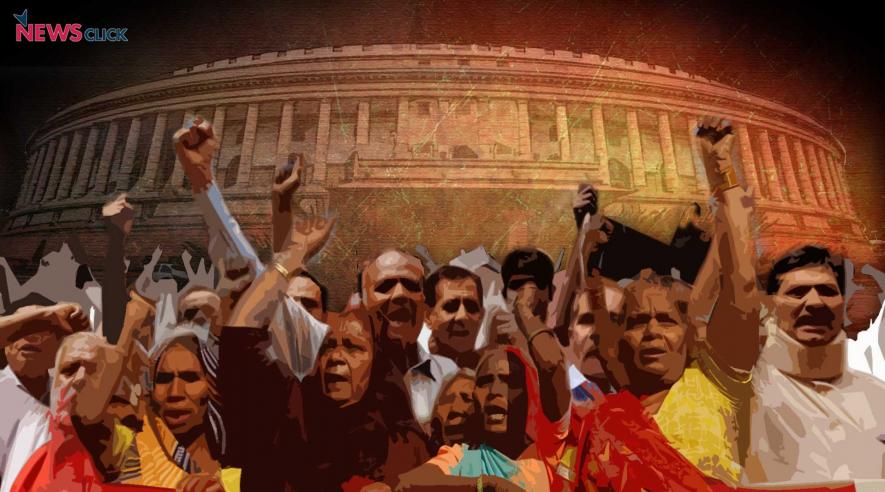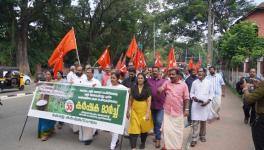Country Gears Up for Historic Workers & Farmers Joint Protest on Nov 26-27

“Achhe din (happy days)? This government has pushed us into hell!” says an angry Sukhdev Prasad, a lathe machine operator in one of Ghaziabad’s industrial areas. His contempt for the Narendra Modi government, and his withering comment on the now-forgotten promise made by Prime Minister Modi, is matched only by his simmering anger.
“We are barely able to survive, ground down between price rise on the one hand and low wages on the other. Now, they have changed labour laws so that employers are sitting on our chests,” he adds, referring to the new Labour Codes that have relaxed rules for hire-and-fire, introduced fixed-term employment and made trade union activity difficult.
Sukhdev and his co-workers are looking forward to the general strike on November 26, called by 10 central trade unions to demand roll-back of the new labour laws and also scrap the three new farming related laws that will open up the agrarian sector to corporate entities and lead to low prices for farmers but price hikes for consumers.
On November 19, an unprecedented meeting of the Joint Platform of Trade Unions and the umbrella forum of farmers’ organisations (All India Kisan Sangharsh Coordination Committee) that has over 300 constituent organisations, took place to chalk out the strategy for what could be a watershed moment in India’s long history of peoples’ struggles. Never before has there been such close coordination between the most oppressed classes, the farmers and agricultural labourers, converging with industrial workers and employees in public and private sectors.
This may lead to not only the general strike of November 26, one of the biggest and most effective ones but the farmers’ march to Delhi, planned to coincide with the strike would take this protest into hitherto uncharted territory.
Farmers Set to Occupy Roads Leading to Delhi
According to the All India Kisan Sabha (AIKS), farmers from neighbouring states are planning to move to Delhi from different points and will be coming prepared with food and bedding for spending as much time as the government forces them to.
“Over two lakh farmers from Punjab, Haryana, West Uttar Pradesh, Rajasthan and Madhya Pradesh will be moving to Delhi to participate in a massive rally, demanding withdrawal of the three agriculture related laws, and also, implementation of Swaminathan Commission recommendations on Minimum Support Price, and waiving of all debt. If the government tries to stop them en route, all roads to the Capital will be jammed indefinitely,” said Hannan Mollah, general secretary of AIKS, one of the leading members of the AIKSCC.
“The time to protest is over because the Modi government is not listening – the time has come to resist on the streets,” Mollah asserted, reflecting the mood of farmers.
Elsewhere in the country, farmers will join workers and employees on strike in a coordinated action that has been fine-tuned over the past two months. Farmers will hold massive demonstrations at state Assemblies or Raj Bhawans, and even at District Collectors’ offices throughout the country. Coupled with the workers strike, this is likely to paralyse the countryside to varying degrees across India.
26th Strike Continues Wave of Industrial Protests
Early in October, a national convention organised by the Joint Platform had called for the strike, the first to be held during the pandemic, and the second such strike this year. The first one was observed on January 8, and had reported participation of two crore (20 million) workers, making it the biggest strike in history.
Since the convention, which was attended online by nearly one lakh workers, the central trade unions and dozens of independent federations have been campaigning across the country, in all industrial areas, big and small. Major sectors of the economy, including steel, coal, port and dock, telecom, plantation, transport, construction, banking, insurance, power are likely to be affected by the strike. In many other sectors, like the railways and among government employees (both, Central and states) protests will be held.
The strike comes in continuation of a series of industrial actions over the past several years led by the joint platform, which included protests and/or strikes by coal workers, bank and insurance employees, defence production employees, telecom (BSNL) employees, oil and gas sector employees, transport workers, etc. Besides these, all-India level strikes have also been held periodically.
These ever-broadening protests by workers and employees were against policies of refusal to increase wages, increasing contractualisation of workforce, dilution and dismantling of protective labour laws, price rise and unemployment, stopping the sale of country’s resources (both natural and industrial) to domestic or foreign capital among other issues.
Since March this year, after the COVID-19 pandemic started sweeping across the country and an ill-conceived and mismanaged lockdown devastated the lives of poor, workers and employees have been fighting for income support, end to retrenchment and closures, expanding the public distribution system, etc.
Meanwhile, farmers and agricultural labourers in India too were on the warpath because of increasing economic ruin, low returns to their produce, stagnant wages, forcible land acquisition, and increasing dominance of big traders and corporate entities over agrarian production, trade and produce pricing.
Both the streams were organically drawn closer over time, both because they represented different exploited sections in India, and also because both were suffering at the hands of the incumbent Modi government.
It is this unity that will be exhibited in the coming strike/protest on November 26-27. For the workers – whether in the organised or unorganised sectors – and employees, as for the small, marginal and middle level farmers (making up 90% of Indian farmers) and the vast army of rural labourers, this is a ‘do or die’ battle. That is why the wave of energy and enthusiasm being reported from all corners of the country as the strike/protest days draw near.
Get the latest reports & analysis with people's perspective on Protests, movements & deep analytical videos, discussions of the current affairs in your Telegram app. Subscribe to NewsClick's Telegram channel & get Real-Time updates on stories, as they get published on our website.























